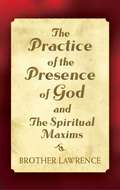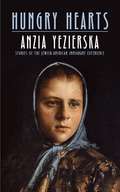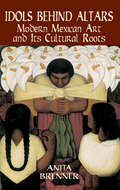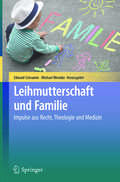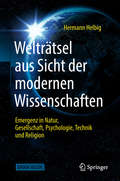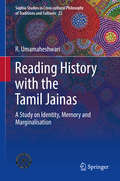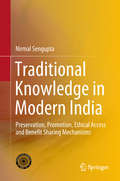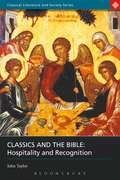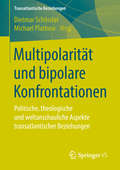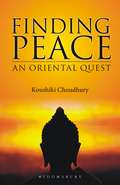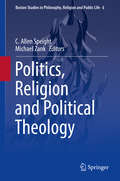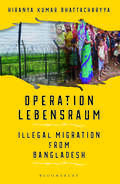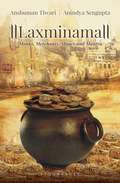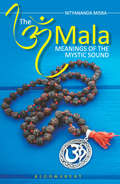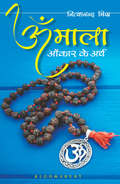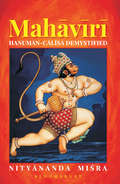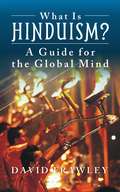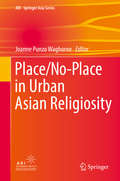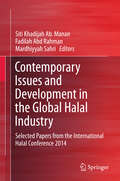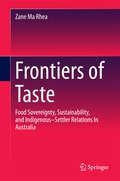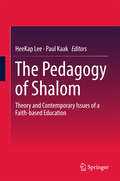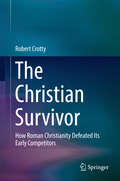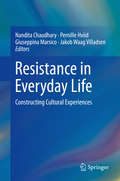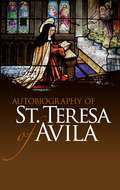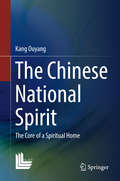- Table View
- List View
The Practice of the Presence of God and The Spiritual Maxims
by Brother Lawrence"Believe me, count as lost each day you have not used in loving God." — Brother LawrenceThis simply written little book about prayer and Christian life conveys a humble man's thoughts on the importance of experiencing God's love. A seventeenth-century French Carmelite, Brother Lawrence spent much of his time in the kitchen of a Paris monastery. Of this experience, he said: "The time of business does not with me differ from the time of prayer, and in the noise and clatter of my kitchen … I possess God in as great tranquility as if I were upon my knees at the blessed sacrament."A collection of Lawrence's messages given to those who lived around him, this book contains The Practice of the Presence of God and The Spiritual Maxims. Both have much to say to modern man about living a spiritual life in a busy world. More widely read today than ever, these two classics — each an easily accessible primer of practical Christian devotion — comprise a particularly good selection with which to begin spiritual studies.
Hungry Hearts: Stories of the Jewish-American Immigrant Experience
by Anzia Yezierska"An intimate glimpse into the lives of Jewish immigrants in the early 1900's." -- Jefferson State Community CollegeTen tales by a Jewish-American author of the early twentieth century offer timeless depictions of immigrants' struggles and dreams. Set in New York City's teeming Lower East Side, this lost masterpiece provides rich psychological portraits of mothers, daughters, and sisters as they attempt to find places in the New World. During her early childhood, Anzia Yezierska (c. 1880-1970) emigrated from Poland to New York City, where she worked in sweatshops by day and studied English at night. She drew upon her own experiences to write these stories as well as novels and screenplays focusing on issues of acculturation and assimilation. Hungry Hearts, which originally appeared in 1920, inspired a popular film and holds the historic distinction of being the first publication by a Jewish-American woman writer.
Idols Behind Altars: Modern Mexican Art and Its Cultural Roots
by Anita BrennerArt critic, historian and journalist Anita Brenner (1905-1974) is acknowledged to be one of the most important and perceptive writers on the art, culture, and political history of Mexico. Idols Behind Altars is her influential historical and critical study of modern Mexican art and its roots. It was one of the first books to afford Mexican art the same serious considerations as European and Asian art and remains indispensable for anyone interested in the subject. The works of such major figures as Diego Rivera, Jóse Clemente Orozco, David Alfaro Siqueiros, Francisco Goitia and Jean Charlot are examined in the cultural context of pre-Columbian times through the 19th century. Brenner's astute analysis of Mexican history, her keen insights into revolutionary politics, and her passionate advocacy of Mexican art infuse this book with seminal importance. 117 illustrations--including some early photographs by Edward Weston--enhance the text.
Leihmutterschaft und Familie: Impulse aus Recht, Theologie und Medizin
by Edward Schramm Michael WermkeDas Buch betrachtet das Thema Leihmutterschaft aus einer breit angelegten, interdisziplinären Perspektive. In Deutschland ist die Leihmutterschaft verboten, in vielen anderen Ländern legal. Viele Menschen erfüllen sich den Wunsch nach einem Kind daher im Wege einer Leihmutterschaft im Ausland. Das Buch nimmt dies zum Anlass, aktuelle Erkenntnisse und Impulse aus der Rechtswissenschaft, Theologie, Soziologie, kindlichen Entwicklungspsychologie, Medizin, Genetik und Philosophie zu diesem Phänomen aufzugreifen und zu analysieren. Im Mittelpunkt steht die Frage, inwiefern sich das Wohl des Kindes, die Interessen der Leihmütter sowie die Bedürfnisse der Wunscheltern in der deutschen Rechtsordnung, der sozialen Wirklichkeit und den kirchlichen Institutionen widerspiegeln.
Welträtsel aus Sicht der modernen Wissenschaften: Emergenz in Natur, Gesellschaft, Psychologie,Technik und Religion
by Hermann HelbigWelträtsel und wunderbare Erscheinungen haben die Menschen von jeher fasziniert. Das vorliegende Kompendium vermittelt einen systematischen Überblick über die damit verbundenen Fragen und diskutiert sie aus einer wissenschaftlichen Perspektive. Dabei wird der Bogen vom Makrokosmos bis hin zur Welt der elementaren Teilchen gespannt; Probleme der Entstehung und des Vergehens von Leben werden ebenso behandelt wie die ungelösten Rätsel des menschlichen Bewusstseins und der Geschichte. Wie ein roter Faden zieht sich durch das Buch das faszinierende Phänomen der Emergenz, d.h. das Erscheinen von Eigenschaften in einem komplexen System, die an dessen Bestandteilen nicht zu beobachten sind. Dieses Phänomen ist nicht nur im Bereich von Natur und Gesellschaft anzutreffen, sondern auch in der Künstlichen Intelligenz. Selbst in der Religion und bei der Herausbildung eines globalen Weltbewusstseins könnte es eine entscheidende Rolle spielen.
Reading History with the Tamil Jainas: A Study on Identity, Memory and Marginalisation (Sophia Studies in Cross-cultural Philosophy of Traditions and Cultures #22)
by R. UmamaheshwariThis book provides a social history of the Tamil Jainas, a minority community living in Tamil Nadu in south India. It holds special significance in the method of studying the community, living in villages of Tamil Nadu and retrieving their perspectives on their past. This is a new approach in terms of historiography from extant works on Jainism in south India. A major feature of this book is the hitherto uncovered aspect of the question of language and identity, caste and the modern socio-political movements in Tamil Nadu, such as the Self-Respect Movement (initiated by ‘Periyar’), in which some Tamil Jainas were active participants. Special features in the book include photographs of the community and monuments, maps, and a unique style, which combines a journalistic approach and academic historical research. This book is of interest to readers of Tamil language and history, and to anyone working on the idea of politics of marginalisation of religious identities, ideas of memory, and community narratives of shared history in the face of religious persecution.
Traditional Knowledge in Modern India: Preservation, Promotion, Ethical Access and Benefit Sharing Mechanisms
by Nirmal SenguptaThis book demonstrates how traditional knowledge can be connected to the modern world. Human knowledge of housing, health and agriculture dates back thousands of years, with old wisdom developing and becoming modern. But in the past few decades, global communities have increasingly become aware that some of this valuable knowledge has fallen by the wayside. This has sparked systematic efforts at the local, national and global levels to connect this neglected knowledge to the modern world.It discusses the origin of the topic, its importance, recent developments in India and abroad, and what is being done and still needs to be done in order to preserve India’s traditional knowledge. The discussions address a broad range of fields and organizations: from Basmati rice to Ayurvedic cosmetics; from traditional irrigation and folk music to modern drug discovery and climate change adaptation; and from the Biodiversity Convention to the WHO, WTO and WIPO.
Classics and the Bible: Hospitality and Recognition (Classical Literature and Society)
by John Taylor"Classics and the Bible" looks at story-patterns and themes which Greek and Latin literature shares with the Hebrew scriptures and the New Testament. Direct influence or a common source can explain some similarities, but uncannily parallel plots and forms of expression seem more often to occur independently. Classical and biblical texts constantly illuminate each other. Hospitality and recognition are central themes in both traditions, and also metaphors about the relation between them. Classical and biblical authors alike tell stories which need to be read in the light of other stories. The relation between the present and the heroic past is crucial to both traditions, and both raise fundamental questions about the relation of text and reader. The first three chapters consider the subject from the classical side: Homer, the Greek tragedians and Plato, and Virgil; the fourth turns to the New Testament; and the fifth to aspects of later reception. Readers should ideally be equipped with a Bible, English translations of a few major classical authors, and an open mind.
Multipolarität und bipolare Konfrontationen
by Dietmar Schössler Michael PlathowDieser interdisziplinäre Sammelband vereint in zehn Beiträgen Analysen bi- und multipolarer Relationen, durch die potentielle Chancen, aber auch problematische Implikate vor Augen treten.Der Inhalt„Ironie“. Interpretationsmodell der Historie und ihre Bedeutung für Reinhold Niebuhrs politische Theologie heute ● Über Fremdheit und Selbstfremdheit der Kirchen im Kontext eskalierender Kulturkämpfe ● Politik der Differenz vs. Anerkennung im Zeichen radikaler Alterität ● Ernst Troeltsch und Max Weber – Religionstheorie in transatlantischer Perspektive ● ‚Neuer Atheismus‘ und ‚Kreationismus‘ – Transatlantische Zwillings-Phänomene ● Transatlantic Networks and the German-American Protestant Exchange ● Paul Tillichs Emigration in die Vereinigten Staaten und sein theologisches Reden über die Grenze ● Beobachtungen zum Weg von Leonardo Boff ● Sicherheitspolitischer Dialog zwischen transatlantischem Bündnis und dem Nahen Osten in Zeiten des geopolitischen UmstrukturierungsprozessesDie HerausgeberProf. Dr. em. Dietmar Schössler war Hochschullehrer für Politik- und Sozialwissenschaften an den Universitäten Mannheim, Frankfurt am Main und München (Universität der Bundeswehr).Prof. Dr. Michael Plathow ist Hochschullehrer für Systematische Theologie an der Universität Heidelberg.
Finding Peace: An Oriental Quest
by Koushiki ChoudhuryThis book explores the joyous, hope-filled and life-changing philosophies of Nichiren Buddhism and Rabindranath Tagore the practice of which empower us, transforming our sufferings, bringing forth our limitless potential and giving us the courage and confidence to overcome any adversity, and fulfill our dreams. In essence, the philosophies of Nichiren and Tagore enable us to find peace and happiness.
Politics, Religion and Political Theology (Boston Studies in Philosophy, Religion and Public Life #6)
by C. Allen Speight Michael ZankThis new volume gives discursive shape to several key facets of the relationship among politics, theology and religious thought. Powerfully relevant to a wealth of further academic disciplines including history, law and the humanities, it sharpens the contours of our understanding in a live and evolving field. It charts the mechanisms by which, contrary to the avowed secularism of many of today’s polities, theology and religion have often, and sometimes profoundly, shaped political discourse. By augmenting this broader analysis with a selection of authoritative papers focusing on the prominent sub-field of political theology, the anthology offsets a startling academic lacuna. Alongside focused analysis of subjects such as conscience, secularism and religious tolerance, the discussion of political theology examines the tradition’s critical moments, including developments during the post-World War I Weimar republic in Germany and the epistemological imprint the theory has left behind in works by political thinkers influenced by the three major monotheistic traditions.
Operation Lebensraum: Illegal Migration from Bangladesh
by Hiranya BhattacharyyaThe story of human migration is as old as the story of Homo sapiens. The innate tendency to survive and achieve better living conditions has proved to be an unending process. The ethnic groups with a very high growth of population have spread out all over the world for more living space spawning unforeseen socio-economic and socio-political unrest and conflict. Most prominent in this regard have been the migration from China and Bangladesh that has continued with increasing momentum since the past several decades. Operation Lebensraum: Illegal Immigration from Bangladesh discusses the entire gamut of migration from Bangladesh into India with a focus on Assam – its origins during the colonial period and continuance during the post-Independence phase, impact, the government's failures to comprehend the nature of the problem and the ways and means to tackle the phenomenon which has already assumed an uncontrollable proportion and fuelled large scale disturbances. The book also draws a comparison of the episode with similar events around the world and especially the policies of the US government in tackling illegal migration from Mexico.
Laxminama: Monks, Merchants, Money and Mantra
by Anshuman Tiwari Anindya SenguptaEmpire. Trade. Religion.Three crucial forces that have been almost equally responsible for shaping human civilization so far. Yet, the politics of empire has dominated history and popular discussion. Irrespective of the political upheavals, however, India has always been an open market-welcoming traders from far-off lands, promising them a fair bargain. Indian entrepreneurs since ages had developed their own sophisticated institutions and wide community-based networks. This open, liberal and robust 'bazaar economy' thrived unhindered till the advent of European trading companies, who brought with them the notions of monopoly and state controls. Business in India blossomed in tune with liberal religious thought and Indian intellectual tradition always fostered the spirit of questioning. Laxminana is an account of how the country's open market and its liberal religious outlook have nurtured each other throughout the centuries. Told through a medley of stories, this is the saga of India's socioeconomic power that has characterized not only the country's vibrant pluralistic society but also much of global history. An untold narrative of India's geographies, products and pioneers this is an unforgettable album of heroes, who championed game-changing ideas at the intersection of faith and enterprise.
The Om Mala: Meanings of the Mystic Sound
by Nityanand MisraThe OM Mala is a book (and a mala or a rosary) about just one word-OM. OM is one of the shortest Sanskrit words, and yet is perhaps the most powerful one, besides being a globally recognized mystic mantra.The OM Mala gives 84 names of OM from Sanskrit texts and explains their meanings in 109 sections or beads: 108 chanting beads and one 'sumeru' bead. Each bead offers the meaning(s), explanation, traditions, etymology, and quotations for one or more names of OM. The book covers rare names of OM like 'shrutipada' and 'rasa' as well as common names like 'om', 'udgitha', and 'pranava'. Popular meanings (like Brahma-Vishnu-Shiva) and rare meanings (like inhalation, holding the breath, and exhalation) are included.The book contains teachings and narratives related to OM from Veda-s, Upanishad-s, Smriti-s, Purana-s, Ramayana, Mahabharata, Gita, Yoga, Tantra, Vaishnavism, Shaivism, and Shaktism. Pearls on OM from poems, plays, and works on music and Ayurveda are presented. The use of OM in Yogic breathing and meditation is explained and the explanations/relevance of OM in Jainism, Buddhism, and Sikhism is briefly touched upon. The OM Mala is a mini-encyclopaedia on OM and associated concepts in Indian religions and culture.
Om Mala: Omkar Ke Arth
by Nityanand MisraThe OM Mala is a book (and a mala or a rosary) about just one word-OM. OM is one of the shortest Sanskrit words, and yet is perhaps the most powerful one, besides being a globally recognized mystic mantra.The OM Mala gives 84 names of OM from Sanskrit texts and explains their meanings in 109 sections or beads: 108 chanting beads and one 'sumeru' bead. Each bead offers the meaning(s), explanation, traditions, etymology, and quotations for one or more names of OM. The book covers rare names of OM like 'shrutipada' and 'rasa' as well as common names like 'om', 'udgitha', and 'pranava'. Popular meanings (like Brahma-Vishnu-Shiva) and rare meanings (like inhalation, holding the breath, and exhalation) are included.The book contains teachings and narratives related to OM from Veda-s, Upanishad-s, Smriti-s, Purana-s, Ramayana, Mahabharata, Gita, Yoga, Tantra, Vaishnavism, Shaivism, and Shaktism. Pearls on OM from poems, plays, and works on music and Ayurveda are presented. The use of OM in Yogic breathing and meditation is explained and the explanations/relevance of OM in Jainism, Buddhism, and Sikhism is briefly touched upon. The OM Mala is a mini-encyclopaedia on OM and associated concepts in Indian religions and culture.
Mahaviri: Hanuman Chalisa Demystified
by Nityanand MisraThe Hanuman Chalisa authored by Goswami Tulsidas is one of the most popular Hindu devotional hymns. The 'Mahaviri' Hindi commentary (1984) by Swami Rambhadracharya has been acclaimed as the best treatise on the Hanuman Chalisa. This book presents an annotated and expanded English translation of the 'Mahaviri' commentary by Nityanand Misra.Each of the 43 verses of the 'Hanuman Chalisa' is explained in three stages. The first phase being a word-for-word translation to help the reader understand the literal meaning of each word in a verse. The second is a simple English translation of each verse. This third and final phase is an informed commentary on the true meaning of the verse, explaining the deep essence of the text with citations from authoritative Hindu scriptures (the Vedas, Upanishads, Puranas, Ramayana, Mahabharata, Gita, etc.) and other works of Goswami Tulsidas. All such citations are also translated into English.Following the commentary, Misra also provides five useful appendices for advanced readers. These include more than 120 endnotes (annotations), a detailed note on the prosody and rhythm of all the verses for chanters, the musical notation of the traditional melody of the Hanuman Chalisa for devotional singers and instrumentalists, and two alphabetical indexes for all words and verses used in the hymn.The book is a must-have for reciters and singers of the Hanuman Chalisa who want to understand the deep essence of Tulsidas's timeless hymn to Hanuman. It targets laypersons as well as scholarly readers. The design of the book, including font sizes and line spacing, is suitable for the elderly as well. The book has reached thousands of readers across the globe and has been praised as “the most comprehensive guide to the Hanuman Chalisa available in English”. It has been loved by readers for not only its scholarship and research, but also for its beautiful production, aesthetic typeface, attractive layout, and excellent footnotes and appendices.
What is Hinduism?: A Guide for the Global Mind
by David FrawleyWhat Is Hinduism? provides one of the most provocative, engaging and detailed examinations of this oldest religious and spiritual tradition in the world. Followed by over a billion people, including a great majority in India, Hinduism is the third largest religion in the world. The teachings of Yoga and Vedanta are followed by millions in every continent. Enriched with a profound pluralistic view, Hinduism emphasizes that the Truth is One but has many paths. Yet, despite its universality, Hinduism remains the most misunderstood of the world's major religions, partly because of its antiquity and the vast extent of its teachings. Acknowledging the importance of the religion and its growing influence globally, David Frawley has addressed the prime teachings of Hinduism, its role in India, its place in the information age and has compiled an exhaustive set of questions and answers dwelling on all the significant issues. This essential learning helps us understand our spiritual heritage as a species and the place of India among the greatest civilizations of the world- ancient and modern. Further, the book charts out how Hindus can overcome the challenges confronting them today and communicate their diverse tradition more effectively, making it an ideal book for the Hindu youth.
Place/No-Place in Urban Asian Religiosity (ARI - Springer Asia Series #5)
by Joanne Punzo WaghorneThis book discusses Asia’s rapid pace of urbanization, with a particular focus on new spaces created by and for everyday religiosity. The essays in this volume – covering topics from the global metropolises of Singapore, Bangalore, Seoul, Beijing, and Hong Kong to the regional centers of Gwalior, Pune, Jahazpur, and sites like Wudang Mountain – examine in detail the spaces created by new or changing religious organizations that range in scope from neighborhood-based to consciously global. The definition of “spatial aspects” includes direct place-making projects such as the construction of new religious buildings – temples, halls and other meeting sites, as well as less tangible religious endeavors such as the production of new “mental spaces” urged by spiritual leaders, or the shift from terra firma to the strangely concrete effervesce of cyberspace. With this in mind, it explores how distinct and blurred, and open and bounded communities generate and participate in diverse practices as they deliberately engage or disengage with physical landscapes/cityscapes. It highlights how through these religious organizations, changing class and gender configurations, ongoing political and economic transformations, continue as significant factors shaping and affecting Asian urban lives. In addition, the books goes further by exploring new and often bittersweet “improvements” like metro rail lines, new national highways, widespread internet access, that bulldoze – both literally and figuratively – religious places and force relocations and adjustments that are often innovative and unexpected. Furthermore, this volume explores personal experiences within the particularities of selected religious organizations and the ways that subjects interpret or actively construct urban spaces. The essays show, through ethnographically and historically grounded case studies, the variety of ways newly emerging religious communities or religious institutions understand, value, interact with, or strive to ignore extreme urbanization and rapidly changing built environments.
Contemporary Issues and Development in the Global Halal Industry: Selected Papers from the International Halal Conference 2014
by Siti Khadijah Ab. Manan Fadilah Abd Rahman Mardhiyyah SahriThis book features more than 50 papers presented at the International Halal Conference 2014, which was held in Istanbul and organised by the Academy of Contemporary Islamic Studies of Universiti Teknologi MARA. It addresses the challenges facing Muslims involved in halal industries in meeting the increasing global demand.The papers cover topics such as halal food, halal pharmaceuticals, halal cosmetics and personal care, halal logistics, halal testing and analysis and ethics in the halal industry. Overall, the volume offers a comprehensive point of view on Islamic principles relating to the halal business, industry, culture, food, safety, finance and other aspects of life.The contributors include experts from various disciplines who apply a variety of scientific research methodologies. They present perspectives that range from the experimental to the philosophical. This volume will appeal to scholars at all levels of qualification and experience who seek a clearer understanding of important issues in the halal industry.
Frontiers of Taste: Food Sovereignty, Sustainability and Indigenous–Settler Relations In Australia
by Zane Ma RheaThis book provides a critical, multiperspective, sociohistorical analysis of the role of food in postcolonial Indigenous, British and French settler relations. Drawing on archival resources from Australian explorers, settlers and nation builders, the book argues that contemporary issues of food security, sovereignty and sustainability have been significantly shaped by the colonial impact on human foodways. The author goes on to enhance readers’ understanding of how contact between inhabitants and newcomers was shaped and informed by food, and how these engagements established a modus vivendi that carries through to the present day. Based on the assessment of archival records, it uses a comparative, socio-historical lens to investigate contact between Indigenous and non-Indigenous people where the exchange of food or knowledge about food took place. It finds that the transfer of food and food knowledge was multifaceted, and the flow of food knowledge occurred in both directions, although these exchanges were neither symmetrical nor balanced. It also analyzes and discusses food as a focal point of activity. The final chapter offers an assessment of the potential for the development of a sustainable, nutritious, tasty Australian cuisine that moves beyond the tropes and stereotypical narratives embedded into colonial Indigenous-settler relations in the context of food. If this was accepted by all Australians, it would allow opportunities to be created for Indigenous Australians to develop food products for the market that are sustainable, economically viable and developed in ways that are culturally appropriate.
The Pedagogy of Shalom: Theory and Contemporary Issues of a Faith-based Education
by HeeKap Lee Paul KaakBased on the teachings of Jesus and a biblical foundation, this book presents a new framework for education and teaching, referred to as the shalom education model, that addresses four essential questions in education (why teach, what to teach, how to teach and who are teachers?). After explaining the theoretical background of shalom, the book investigates a range of contemporary educational issues including gender identity, bullying, disability, linguistic and cultural diversity, and social justice, and presents practical guidelines that can be applied to classroom teaching. The book also emphasizes the role of teachers as missional leaders who help students unlock their full potential.
The Christian Survivor: How Roman Christianity Defeated Its Early Competitors
by Robert CrottyThe book puts the current interest in historical Jesus research into a proper historical context, highlighting Gnosticism’s lasting influence on early Christianity and making the provocative claim that nearly all Christian Churches are in some way descended from Roman Christianity. Breaking with the accepted wisdom of Christianity’s origins, the revised history it puts forward challenges the assumptions of Church and secular historians, biblical critics and general readers alike, with profound repercussions for scholarship, belief and practice.
Resistance in Everyday Life: Constructing Cultural Experiences
by Nandita Chaudhary Pernille Hviid Giuseppina Marsico Jakob Waag VilladsenThis book is about resistance in everyday life, illustrated through empirical contexts from different parts of the world. Resistance is a widespread phenomenon in biological, social and psychological domains of human cultural development. Yet, it is not well articulated in the academic literature and, when it is, resistance is most often considered counter-productive. Simple evaluations of resistance as positive or negative are avoided in this volume; instead it is conceptualised as a vital process for human development and well-being. While resistance is usually treated as an extraordinary occurrence, the focus here is on everyday resistance as an intentional process where new meaning constructions emerge in thinking, feeling, acting or simply living with others. Resistance is thus conceived as a meaning-making activity that operates at the intersection of personal and collective systems. The contributors deal with strategies for handling dissent by individuals or groups, specifically dissent through resistance. Resistance can be a location of intense personal, interpersonal and cultural negotiation, and that is the primary reason for interest in this phenomenon. Ordinary life events contain innumerable instances of agency and resistance. This volume discusses their manifestations, and it is therefore of interest for academics and researchers of cultural psychology, cultural studies, anthropology, sociology, and human development.
Autobiography of St. Teresa of Avila
by St. Teresa of AvilaIn this landmark of Christian mysticism, the revered Carmelite nun presents moving accounts of her profound religious experiences and ultimate union with God. St. Teresa wrote this memoir at the behest of her confessor. It offers a warm, accessible account of her transformation into an impassioned leader and reformer of church doctrine.St. Teresa recounts her childhood and education in sixteenth-century Spain, her physical afflictions and spiritual crises, her many visions and mystical encounters, and her determination to embrace the contemplative life. In describing the ascent of the soul, she explains the core of her theology as a four-stage process that progresses from mental prayer to divine rapture. Next to Don Quixote, this timeless work constitutes Spain's most popular prose classic. It forms an excellent introduction to the saint's other writings and to the Christian tradition of mystical literature.
The Chinese National Spirit: The Core of a Spiritual Home
by Kang OuyangThis book discusses the Chinese nation’s spiritual home in a modern context. It analyzes various aspects of the problem, including background, theory, history, recent advances and solutions, from a global view. In discussing the development of Chinese national spirit, it also refers to western experiences of national culture and national spirit. To build the spiritual home, the traditional culture, values and faith need to be learned, analyzed and adapted to the modern context. Doing so helps to maintain the traditional characteristics while at the same time reinforcing new characteristics. This model can be applied to many countries around the globe. Additionally, the author points out that in the construction of Chinese national spirit it is also important to consider positive elements from different cultures in other nations.
